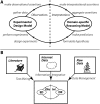Enabling collaborative research using the Biomedical Informatics Research Network (BIRN)
- PMID: 21515543
- PMCID: PMC3128398
- DOI: 10.1136/amiajnl-2010-000032
Enabling collaborative research using the Biomedical Informatics Research Network (BIRN)
Abstract
Objective: As biomedical technology becomes increasingly sophisticated, researchers can probe ever more subtle effects with the added requirement that the investigation of small effects often requires the acquisition of large amounts of data. In biomedicine, these data are often acquired at, and later shared between, multiple sites. There are both technological and sociological hurdles to be overcome for data to be passed between researchers and later made accessible to the larger scientific community. The goal of the Biomedical Informatics Research Network (BIRN) is to address the challenges inherent in biomedical data sharing.
Materials and methods: BIRN tools are grouped into 'capabilities' and are available in the areas of data management, data security, information integration, and knowledge engineering. BIRN has a user-driven focus and employs a layered architectural approach that promotes reuse of infrastructure. BIRN tools are designed to be modular and therefore can work with pre-existing tools. BIRN users can choose the capabilities most useful for their application, while not having to ensure that their project conforms to a monolithic architecture.
Results: BIRN has implemented a new software-based data-sharing infrastructure that has been put to use in many different domains within biomedicine. BIRN is actively involved in outreach to the broader biomedical community to form working partnerships.
Conclusion: BIRN's mission is to provide capabilities and services related to data sharing to the biomedical research community. It does this by forming partnerships and solving specific, user-driven problems whose solutions are then available for use by other groups.
Conflict of interest statement
Figures




References
-
- The Globus Alliance The Globus Toolkit. http://www.globus.org/toolkit/
-
- The Globus Alliance GridFTP. http://www.globus.org/toolkit/data/gridftp/
-
- Allcock W, Bresnahan J, Kettimuthu R, et al. The Globus Striped GridFTP Framework and Server. SC05 Conference; 2005; Seattle, WA, 2005:54
-
- Chervenak AL, Schuler R, Ripeanu M, et al. The globus replica location service: design and experience. IEEE Trans Parallel Distrib Syst 2009;20:1260–72
-
- The Globus Alliance Replica Location Service (RLS). http://www.globus.org/toolkit/

